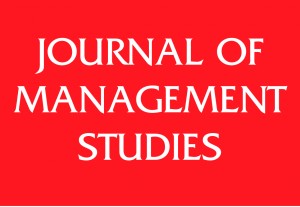
SPECIAL ISSUE:
CORPORATE ENTREPRENEURSHIP AND FAMILY BUSINESS:
LEARNING ACROSS DISCIPLINES
Submission Deadline: 15 June 2018
Guest Editors:
Tommaso Minola, University of Bergamo, Italy
Franz W. Kellermanns, University of North Carolina at Charlotte, USA
Nadine Kammerlander, WHU – Otto Beisheim School of Management, Germany
Frank Hoy, Worcester Polytechnic Institute, USA
JMS Editor: Riikka Sarala, University of North Carolina at Greensboro, USA
Background to Special Issue
Scholars have been calling for research into corporate entrepreneurship (CE) for decades (Guth and Ginsberg, 1990; Schendel and Hofer, 1979). Early contributions to the literature proposed recommendations for introducing entrepreneurial and innovative behaviour into large, complex organizations, while acknowledging that successful applications were the exception rather than the rule (Block and MacMillan, 1993; Kanter, 1984; Pinchot, 1985). Although resistance to innovative behaviour within large organizations can still be found (Vuori and Quy, 2015), evidence now indicates greater acceptance of entrepreneurship by corporate leaders (Clarysse et al., 2011; Czarnitzki et al., 2010; Dess and Lumpkin, 2005; Dunlap-Hinkler et al., 2010; Zahra and Covin, 1995). After resolving initial definitional issues (Sharma and Chrisman, 1999), interest in CE has been growing in strategic management research (Covin and Miles, 2007; Hitt and Ireland, 2000).
McKelvie et al. (2014) proposed that there is a need to increase research on CE strategies in family businesses, offering the following justifications: 1) “strategic management in family businesses differs from non-family businesses based on their systems of governance and needs for family harmony” (p. 340); 2) “family involvement can result in the development of resources unique to family businesses” (p. 340), which can influence CE activities; and 3) “agency problems are thought to influence CE, and family businesses experience different agency problems than non-family businesses” (p. 341). These issues, as well as many others driven by family firm uniqueness, together with family firm dominance across the world, open up fruitful paths for future research.
Early contributions to the family business literature in the 1980s and 1990s were predominantly from consultants as well as based on biographies and autobiographies of business owners. These publications laid frameworks that were mostly unsubstantiated by empirical research but some of them still serve as assumptions for how family businesses should and do operate. One important assumption is that family firms are not as professionally managed as nonfamily businesses (Stewart and Hitt, 2012), suggesting inherent problems in family firms and dysfunctional behaviour that need to be resolved. Contrary to that rather pessimistic view, however, in 2005, Miller and Le Breton Miller published a breakthrough comparison study of family and nonfamily firms in Canada finding superior performance by many family-owned and -managed enterprises. Based on lessons learned from family businesses, those authors were able to formulate recommendations from their research for nonfamily companies. Another disruptive contribution in this regard was a study by Anderson and Reeb, published in 2003, indicating that family-owned firms were more profitable over time than nonfamily corporations. In 2016, a meta-analysis by Duran, Kammerlander, van Essen, and Zellweger revealed that family businesses, and particularly those firms that are managed by later generation family members, are more efficient in their innovation processes leading to higher innovation output as compared to nonfamily firms, despite lower input. Thus, while much attention from scholars continues to be given to problems characterizing family businesses, theories and models are being developed that propose best practices from family businesses that can be applied to other organizations (e.g., König et al., 2013). These and several other highly rigorous contributions, particularly surging from the last decade, have contributed to make family business a research field that fulfils the requirements of top tier management journals, contributes to mainstream management disciplines and even finds ways to give back to business and economics general theories (such as behavioural theory and agency theory) (Gedajlovic et al., 2012; Melin et al., 2014; Sharma, 2010).
The field of CE makes no exception in this respect. So, while we expect a number of contributions to take advantage of CE literature to address the distinctiveness of family firms’ entrepreneurial behaviour in the proposed special issue, we also aim at stimulating contributions for the CE literature in general. That is, research on family business that has the potential to provide insightful suggestions to CE scholars. For example, Minola et al. (2017) provide a developmental perspective to corporate venturing in enterprising families that introduces the concept of norms and attitudes as ‘internal triggers’ of CE. This complements and extends the notion of ‘external triggers’ largely adopted in holistic, process-based models of CE (Kuratko, 2010). In a similar vein, concerns for noneconomic goals (Gomez-Mejia et al., 2011), imprinting of a firm’s legacy (Jaskiewicz et al., 2015; Kammerlander et al., 2015) and stakeholder engagement (Eddleston et al., 2012) have been recently used to explain entrepreneurial behaviour in family firms. They provide insights that are generalizable and customizable also to nonfamily firms. Hence, for the proposed special issue we will also solicit submissions that examine prospective applications from the family firms literature to CE theories, models and practical recommendations (Hoskisson et al., 2011; Teng, 2007; Williams and Lee, 2011).
This special issue seeks to determine the relevance that research findings from studies of CE have for family businesses and the relevance that findings from family business investigations have for CE. While the crossroad of the two fields of research is deemed as promising, it is the reciprocity of the two directions of scholarly contributions that represents the novelty of this special issue. Such area of inquiry has not been satisfactorily addressed in management literature, but it has the potential to stimulate the contributions from a broad scholarly community as well as the interest of a quite vast readership. It could also substantially advance our scholarly understanding of both family business behaviour and CE.
There are many interesting questions that could be addressed in the context of family business, with the aim of capturing their distinctiveness and the sources of such distinctiveness, providing conceptual elements that are generalizable to nonfamily businesses (Miller et al., 2016). The following questions would represent illustrative examples of such research endeavours:
- How are the behavioural antecedents and foundations of CE represented in family and nonfamily firms?
- How do capabilities and attitudes towards CE evolve and interact over time? How do these patterns relate to the complexity of the family business system?
- What is the role of social dynamics (such as social exchange, social comparison and social identity processes) in entrepreneurial family firms? How do they affect entrepreneurship-oriented and human resource management practices?
- How are different types of CE initiatives (e.g., internal vs. external, explorative vs. exploitative) affected by the trade-off of economic and noneconomic goals of family firms?
- How does CE create value and by which criteria is this assessed in family vs. nonfamily firms?
- What are the founding conditions of family- and corporate-sponsored new ventures and how do these conditions affect the development of such ventures (e.g., behaviour, performance)?
- How does a family firm’s embeddedness in a local innovation ecosystem affect CE investment and performance?
- When, and under which circumstances, does stewardship behaviour induce individuals within an organization to behave entrepreneurially?
- How and when does psychological ownership emerge and deploy into CE?
- How do family firms conceive, manage and allocate resources in CE? Which resources are particularly valuable?
- What family-related factors and contingencies determine the way CE initiatives are operationally managed (e.g., autonomy, delegation, accountability)?
- How do family firms engage in CE to support the growth of the enterprising family?
- What are the components of family and organizational culture that are at work in promoting and managing CE initiatives?
- How does family involvement determine the emergence of CE initiatives in periods of crisis or declining business performance?
There are no universally accepted definitions of either CE or family business. For the special issue, we require authors to specify how they are defining the terms for their studies, whether conceptual or empirical, in order to assist scholars in assessing and in replicating the studies. We will provide guidance to authors by referencing frequently cited articles addressing the terms including Sharma and Chrisman (1999) for CE and Chua et al. (1999) for family business.
Submission Process and Deadlines
- Manuscripts will be reviewed according to the JMS double-blind review process.
- Submissions should be prepared using the JMS Manuscript Preparation Guidelines (see: http://www.socadms.org.uk/wp-content/uploads/JMS-Manuscript-Preparation-Guidelines.pdf)
- The deadline for submission is 15th June 2018.
- Manuscripts should be submitted by e-mail to jms@durham.ac.uk
- For informal inquires related to the Special Issue, proposed topics and potential fit, and/or the conferences below, please contact the guest editors at ce.fb@gmail.com.
Special Issue Workshop
November 2018 at University of Bergamo (Italy)
To help authors advance their manuscripts, the proponents of the Special Issue will organize a special issue workshop. Authors of R&R manuscripts will be invited to present their papers and react to their colleagues’ papers during the workshop, but presentation at the workshop will not guarantee acceptance of the paper for publication in JMS. Attending the workshop will not be a precondition for acceptance into the Special Issue.
References
Anderson, R. C. and Reeb, D. M. (2003). ‘Founding‐family ownership and firm performance: evidence from the S&P 500’. Journal of Finance, 58, 1301-28.
Block, Z. and MacMillan, I. C. (1993). Corporate Venturing: Creating New Businesses within the Firm. Boston, MA: Harvard Business Press.
Chua, J. H., Chrisman, J. J. and Sharma, P. (1999). ‘Defining the family business by behavior’. Entrepreneurship Theory and Practice, 23, 19-39.
Clarysse, B., Wright, M. and Van de Velde, E. (2011). ‘Entrepreneurial origin, technological knowledge, and the growth of spin-off companies.’ Journal of Management Studies, 48, 1420-42.
Covin, J. G. and Miles, M. P. (2007). ‘Strategic use of corporate venturing’. Entrepreneurship Theory and Practice, 31, 183-207.
Czarnitzki, D., Dick, J. M. H. and Hussinger, K. (2010). ‘The contribution of corporate ventures to radical innovation’. ZEW Discussion Papers, No. 10-060.
Dess, G. G. and Lumpkin, G. T. (2005). ‘The role of entrepreneurial orientation in stimulating effective corporate entrepreneurship’. Academy of Management Executive, 19, 147-56.
Dunlap-Hinkler, D., Kotabe, M. and Mudambi, R. (2010). ‘A story of breakthrough versus incremental innovation: Corporate entrepreneurship in the global pharmaceutical industry’. Strategic Entrepreneurship Journal, 4, 106-27.
Duran, P., Kammerlander, N., van Essen, M. and Zellweger, T. (2016). ‘Doing more with less: Innovation input and output in family firms’. Academy of Management Journal, 59, 1224-64.
Eddleston, K. A., Kellermanns, F. W. and Zellweger, T. M. (2012). ‘Exploring the entrepreneurial behavior of family firms: does the stewardship perspective explain differences?’. Entrepreneurship Theory and Practice, 36, 347-67.
Gedajlovic, E., Carney, M., Chrisman, J. J. and Kellermanns, F. W. (2012). ‘The adolescence of family firm research: Taking stock and planning for the future’. Journal of Management, 38, 1010-37.
Gomez-Mejia, L. R., Cruz, C., Berrone, P. and De Castro, J. (2011). ‘The bind that ties: Socioemotional wealth preservation in family firms’. Academy of Management Annals, 5, 653-707.
Guth, W. D. and Ginsberg, A. (1990). ‘Guest editors’ introduction: Corporate entrepreneurship’. Strategic Management Journal, 11, 5-15.
Hitt, M. A. and Ireland, R. D. (2000). ‚The intersection of entrepreneurship and strategic management research’. In Sexton, D. L. and Landstrom, H. (Eds.), Handbook of Entrepreneurship. Oxford: Blackwell Publishing, 45-63.
Hoskisson, R. E., Covin, J., Volberda, H. W. and Johnson, R. A. (2011). ‘Revitalizing entrepreneurship: The search for new research opportunities’. Journal of Management Studies, 48, 1141-68.
Jaskiewicz, P., Combs, J. G., & Rau, S. B. (2015). ‘Entrepreneurial legacy: Toward a theory of how some family firms nurture transgenerational entrepreneurship’. Journal of Business Venturing, 30, 29-49.
Kammerlander, N., Dessi, C., Bird, M., Floris, M. and Murru, A. (2015). ‘The Impact of Shared Stories on Family Firm Innovation: a Multi-Case Study’. Family Business Review, 28, 332-54.
Kanter, R. M. (1984). Change Masters. New York: Simon and Schuster.
König, A., Kammerlander, N. and Enders, A. (2013). ‘The Family Innovator’s Dilemma: How Family Influence Affects the Adoption of Discontinuous Technologies by Incumbent Firms’. Academy of Management Review, 38, 418-41.
Kuratko, D. F. (2010). ‘Corporate entrepreneurship: An introduction and research review’. In Acs, Z. J. and Audretsch, D. B. (eds), Handbook of Entrepreneurship Research. New York: Springer, 129-63.
McKelvie, A., McKenny, A. F., Lumpkin, G. T. and Short, J. C. (2014). ‘Corporate entrepreneurship in family businesses: Past contributions and future opportunities’. In Melin, L., Nordqvist, M. and Sharma, P. (Eds.), The SAGE Handbook of Family Business. Los Angeles, CA: Sage, 340-63.
Melin, L., Nordqvist, M. and Sharma, P. (Eds.). (2014). The SAGE Handbook of Family Business. Los Angeles, CA: Sage.
Miller, D. and Le Breton-Miller, I. (2005). Managing for the Long Run: Lessons in Competitive Advantage from Great Family Businesses. Boston, MA: Harvard Business Press.
Miller, D., Steier, L. and Breton-Miller, L. (2016). ‘What can scholars of entrepreneurship learn from sound family businesses?’. Entrepreneurship Theory and Practice, 40, 445-55.
Minola, T., Brumana, M., Campopiano, C., Garrett, R. and Cassia, L. (2017). ‘Corporate venturing in family business: A developmental approach of the enterprising family’. Strategic Entrepreneurship Journal, 10, 395-412.
Pinchot, G. (1985). Intrapreneuring: Why You Don’t Need to Leave the Corporation to Become an Entrepreneur. Cambridge, MA: Harper & Row.
Schendel, D. and Hofer, C. W. (Eds.). (1979). Strategic Management: A New View of Business Policy and Planning. Boston, MA: Little Brown.
Sharma, P. and Chrisman, J. J. (1999). ‘Toward a reconciliation of the definitional issues in the field of corporate entrepreneurship’. Entrepreneurship: Theory and Practice, 23, 11-27.
Sharma, P. (2010). ‘Advancing the 3Rs of family business scholarship: Rigor, relevance, reach’. In Stewart, A. Lumpkin, G. T. and Katz, J. (Eds.), Advances in Entrepreneurship, Firm Emergence and Growth. Bingley: Emerald Group, 12, 383-400.
Stewart, A. and Hitt, M. A. (2012). ‘Why can’t a family business be more like a nonfamily business? Modes of professionalization in family firms’. Family Business Review, 25, 58-86.
Teng, B.-S. (2007). ‘Corporate entrepreneurship activities through strategic alliances: A resource-based approach toward competitive advantage’. Journal of Management Studies, 44, 119-42.
Vuori, T. O. and Quy, Q. N. (2015). ‘Distributed attention and shared emotions in the innovation process: How Nokia lost the smartphone battle’. Administrative Science Quarterly, 20, 1-43.
Williams, C. and Lee, S. H. (2011). ‘Political heterarchy and dispersed entrepreneurship in the MNC’. Journal of Management Studies, 48, 1243-68.
Zahra, S. A. and Covin, J. G. (1995). ‘Contextual influences on the corporate entrepreneurship-performance relationship: A longitudinal analysis’. Journal of Business Venturing, 10, 43-58.

